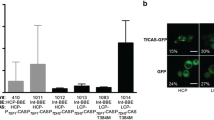Abstract
105 yeast strains from 10 genera and 40 species were evaluated for cell-free production of (R)-phenylacetylcarbinol (PAC), the chiral precursor in the manufacture of the pharmaceuticals ephedrine and pseudoephedrine. Carboligase activity of pyruvate decarboxylase (PDC), forming PAC from benzaldehyde and pyruvate, was found in extracts of 98 strains. PAC was not formed from benzaldehyde and acetaldehyde, an activity of bacterial PDCs from Zymomonas mobilis and Zymobacter palmae. Two interesting groups of candidates were identified in the yeast screening: carboligase activities of Schizosaccharomyces pombe PDCs were very low but showed best resistance to pre-incubation with acetaldehyde and benzaldehyde; and highest carboligase activities combined with medium resistance were found in strains of Candida utilis, C. tropicalis and C. albicans.
Similar content being viewed by others
References
Barnett JA, Payne RW, Yarrow D (2000) Yeasts: Characteristics and Identification, 3rd edn. Cambridge: Cambridge University Press.
Breuer M, Hauer B, Mesch K, Goetz G, Pohl M, Kula M-R (1997) German Patent 19736104 A1.
Bringer-Meyer S, Sahm H (1988) Acetoin and phenylacetylcarbinol formation by pyruvate decarboxylase of Zymomonas mobilis and Saccharomyces carlsbergensis. Biocatalysis 1: 321–331.
Bruhn H, Pohl M, Grötzinger J, Kula MR (1995) The replacement of Trp392 by alanine influences the decarboxylase/carboligase activity and stability of pyruvate decarboxylase from Zymomonas mobilis. Eur. J. Biochem. 234: 650–655.
Chow YS, Shin HS, Adesina AA, Rogers PL (1995) A kinetic model for the deactivation of pyruvate decarboxylase (PDC) by benzaldehyde. Biotechnol. Lett. 17: 1201–1206.
Goetz G, Iwan P, Hauer B, Breuer M, Pohl M (2001) Continuous production of (R)-phenylacetylcarbinol in an enzyme-membrane reactor using a potent mutant of pyruvate decarboxylase from Zymomonas mobilis. Biotechnol. Bioeng. 74: 317–325.
Gruber M, Wassenaar JS (1960) Inhibition of yeast carboxylase by acetaldehyde. Biochim. Biophys. Acta 38: 355–357.
Iwan P, Goetz G, Schmitz S, Hauer B, Breuer M, Pohl M (2001) Studies on the continuous production of (R)-(-)-phenylacetylcarbinol in an enzyme-membrane reactor. J. Mol. Catal. B: Enzym. 11: 387–396.
Juni E (1961) Evidence for a two-site mechanism for decarboxylation of ?-keto acids by ?-carboxylase.J. Biol. Chem. 236: 2302–2308.
Netrval J, Vojtisek V (1982) Production of phenylacetylcarbinol in various yeast species. Eur. J. Appl. Microbiol. Biotechnol. 16: 35–38.
Neuberg C, Hirsch J (1921) An enzyme which brings about union into carbon chain (carboligase). Biochem. Z. 115: 282–310.
Oliver AL, Anderson BN, Roddick FA (1999) Factors affecting the production of L-phenylacetylcarbinol by yeast: a case study. Adv. Microb. Physiol. 41: 1–45.
Raj KC, Ingram LO, Maupin-Furlow JA (2001) Pyruvate decarboxylase: a key enzyme for the oxidative metabolism of lactic acid by Acetobacter pasteurianus. Arch. Microbiol. 176: 443–451.
Raj KC, Talarico LA, Ingram LO, Maupin-Furlow JA (2002) Cloning and characterization of the Zymobacter palmae pyruvate decarboxylase gene (pdc) and comparison to bacterial homologues. Appl. Environ. Microbiol. 68: 2869–2876.
Rosche B, Leksawasdi N, Sandford V, Breuer M, Hauer B, Rogers P (2002a) Enzymatic (R)-phenylacetylcarbinol production in benzaldehyde emulsions. Appl. Microbiol. Biotechnol. 60: 94–100.
Rosche B, Sandford V, Breuer M, Hauer B, Rogers P (2002b) Enhanced production of R-phenylacetylcarbinol (R-PAC) through enzymatic biotransformation. J. Mol. Cat. B: Enzym. 19–20: 109–115.
Rosche B, Sandford V, Breuer M, Hauer B, Rogers P (2001) Biotransformation of benzaldehyde into (R)-phenylacetylcarbinol by filamentous fungi or their extracts. Appl. Microbiol. Biotechnol. 57: 309–315.
Shin HS, Rogers PL (1996) Production of L-phenylacetylcarbinol (L-PAC) from benzaldehyde using partially purified pyruvate decarboxylase (PDC). Biotechnol. Bioeng. 49: 52–62.
Spencer JFT, Spencer DM (1997) Yeasts in Natural and Artificial Habitats. Berlin, Heidelberg: Springer.
Talarico LA, Ingram LO, Maupin-Furlow JA (2001) Production of the Gram-positive Sarcina ventriculi pyruvate decarboxylase in Escherichia coli. Microbiology 147: 2425–2435.
TripathiCM, Agarwal SC, Basu SK (1997) Production of Lphenylacetylcarbinol by fermentation. J. Ferment. Bioeng. 84: 487–492.
Author information
Authors and Affiliations
Corresponding author
Rights and permissions
About this article
Cite this article
Rosche, B., Breuer, M., Hauer, B. et al. Screening of yeasts for cell-free production of (R)-phenylacetylcarbinol. Biotechnology Letters 25, 841–845 (2003). https://doi.org/10.1023/A:1024009807227
Issue Date:
DOI: https://doi.org/10.1023/A:1024009807227




